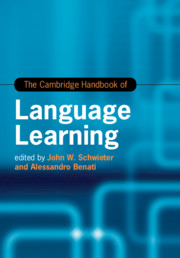Book contents
- The Cambridge Handbook of Language Learning
- Cambridge Handbooks in Language and Linguistics
- The Cambridge Handbook of Language Learning
- Copyright page
- Contents
- Figures
- Tables
- Contributors
- Acknowledgements
- Introduction
- Part I Theories
- Part II Methods
- Part III Skill Development
- Part IV Individual Differences
- Part V Pedagogical Interventions and Approaches
- Part VI Context and Environment
- Part VII Moving Forward
- Index
- References
Part I - Theories
Published online by Cambridge University Press: 25 June 2019
- The Cambridge Handbook of Language Learning
- Cambridge Handbooks in Language and Linguistics
- The Cambridge Handbook of Language Learning
- Copyright page
- Contents
- Figures
- Tables
- Contributors
- Acknowledgements
- Introduction
- Part I Theories
- Part II Methods
- Part III Skill Development
- Part IV Individual Differences
- Part V Pedagogical Interventions and Approaches
- Part VI Context and Environment
- Part VII Moving Forward
- Index
- References
Summary
The relative conformity with which (typically developing) children attain adult grammatical competence—ultimate attainment—and the similarity in developmental paths along which they progress is remarkable (e.g., Ambridge & Lieven, 2011; Clark, 2003; Guasti, 2002; Synder, 2007). This achievement is, however, so ubiquitous and mundane that we seldom marvel at it. Of course, monolingual adult grammars may also differ from one another, especially for some domains of grammar (e.g., Dąbrowska, 1997, 2012), but such variability pales in comparison to the variation in adult non-native second language (L2) grammars. Indeed, the path and outcomes of L2 acquisition can be highly variable from one individual to another, even under seemingly comparable contexts. Individual and group-level factors in adulthood that either do not apply or apply with much less consequence in young childhood conspire to explain at least some of the gamut of L2 variability.
- Type
- Chapter
- Information
- The Cambridge Handbook of Language Learning , pp. 11 - 108Publisher: Cambridge University PressPrint publication year: 2019



